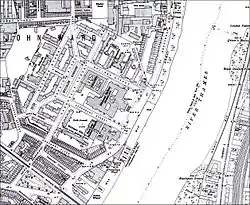Royal Army Medical College
The Royal Army Medical College (RAMC) was located on a site south of the Tate Gallery (now known as Tate Britain) on Millbank, in Westminster, London, overlooking the River Thames. The college moved from the site in 1999 and the buildings are now occupied by the Chelsea College of Arts.
| Royal Army Medical College | |
|---|---|
| Millbank | |
 Royal Army Medical College | |
 Royal Army Medical College Location within Westminster | |
| Coordinates | 51.49039°N 0.12892°W |
| Type | Military College |
| Site information | |
| Owner | Ministry of Defence |
| Operator | |
| Site history | |
| Built | 1907 |
| Built for | War Office |
| In use | 1907-1999 |
History

The site, including that of the Tate Gallery (which opened in 1897), was previously occupied by the Millbank Prison from 1821 to the late 19th century. The college was built by John Henry Townsend and Wilfred Ainslie in Imperial Baroque style. They also designed the adjoining Regimental Officers’ Mess and Commandant's House, in French Renaissance style. The buildings were opened by King Edward VII and Queen Alexandra on 15 May 1907. A statue of Sir James McGrigor, the father of army medicine, originally at the Royal Hospital, Chelsea was moved to the grounds in 1907 and then moved again to the Royal Military Academy Sandhurst in 2000.[1]
Queen Alexandra Military Hospital was built to the north of the Tate Gallery and opened in 1905. Sir Cooper Perry was knighted in 1903 for helping set up the college.[2]
During the First World War the college was used to prepare vaccines, including a vaccine against typhoid which was developed at the college. The college also researched into protection against chemical warfare including the development of gas masks here. In the second World War, the college provided courses in tropical medicine. The college was seriously damaged in 1941 by bombs and the walls of the Tate Gallery nearby still show signs of the damage.[3]
The area around the college including the Tate, former military hospital and other adjacent areas is a conservation area.[4] The former college buildings are now listed.[5]
After teaching transferred to the Queen Alexandra Hospital in Cosham near Portsmouth in 1999,[6] the college closed and the buildings are now occupied by the Chelsea College of Arts.[7]
Commandants of the Royal Army Medical College
(Dates in parentheses are years of service)
- Major-General Bruce Morland Skinner CB CMG MVO (c.1913)
- Surgeon-General Sir David Bruce KCB, FRS,[8] (1914–1919)[9]
- Colonel Henry Edward Manning Douglas (1926–1930)
- Colonel John Southey Bostock CBE (1930)[10]
- Major-General Sir Ralph Bignell Ainsworth Kt, CB, DSO, OBE (1930–1935)[11]
- Major-General William Porter MacArthur KCB (1935–1938)[12]
- Major-General John Dowse CB CBE MC (1948–1949)
- Major-General James Baird (1971–1973)[13]
- Major-General Simon Gavourin (1973–1977)
- Major-General Alan Reay (1977–1979)[14]
- Major-General Robert Noel Evans (1979–1981)
- Major-General Joseph Porter Crowdy CB (1981–1984)
- Major-General Patrick Crawford (1989–1993)[15]
References
- "Statue of Sir James Robert McGrigor B. G., M. D. at Royal Military Academy Sandhurst". British listed buildings. Retrieved 29 December 2017.
- Eason, H. L. (2004). "Perry, Sir (Edwin) Cooper (1856–1938)". Oxford Dictionary of National Biography. Retrieved 5 August 2012.
- "History of 45 Millbank". Retrieved 6 August 2012.
- Millbank Conservation Area – Westminster City Council, January 2005, accessed 6 August 2012
- Southern Block Historic England. "Details from listed building database (1066501)". National Heritage List for England. Retrieved 7 August 2014.
Officers Mess and Commandants House Historic England. "Details from listed building database (1376570)". National Heritage List for England. Retrieved 7 August 2014.
StatueHistoric England. "Details from listed building database (1066502)". National Heritage List for England. Retrieved 7 August 2014.
Former barracks (1) Historic England. "Details from listed building database (1376572)". National Heritage List for England. Retrieved 7 August 2014.
Former barracks (2) Historic England. "Details from listed building database (1376571)". National Heritage List for England. Retrieved 7 August 2014. - "MDHU Portsmouth". Qaranc. Retrieved 13 October 2018.
- "History (Official)". Chelsea.arts.ac.uk. Archived from the original on 3 August 2007. Retrieved 21 May 2009.
- b., J. R. (1932). "Sir David Bruce. 1855–1931". Obituary Notices of Fellows of the Royal Society. 1: 79–85. doi:10.1098/rsbm.1932.0017.
- S R Christophers: 'Bruce, Sir David (1855–1931)' (rev. Helen J Power), Oxford Dictionary of National Biography, Oxford University Press, 2004; online edn, Oct 2008, accessed 23 May 2014
- British Medical Journal (BMJ), 23 August 1930, 2(3633):page307, accessed 23 May 2014
- "AINSWORTH, Major-General Sir Ralph Bignell". Who Was Who, A & C Black, an imprint of Bloomsbury Publishing plc, 1920–2014; online edn, Oxford University Press, 2014 ; online edn, April 2014. Retrieved 28 September 2014.
- "MACARTHUR, Sir William Porter (1884–1964), Lieutenant General". Liddell Hart Centre for Military Archives. King's College London. Retrieved 8 February 2014.
- "BAIRD, Sir James (Parlane) (born 1915), Lieutenant General". Survey of the Papers of Senior UK Defence Personnel, 1900–1975. King's College London – Liddell Hart Centre for Military Archives. Retrieved 2 February 2014.
- "Lieutenant General Sir Alan Reay KBE FRCP Edin". Obituaries. Royal College of Physicians of Edinburgh. Retrieved 17 March 2014.
- "Major-General Patrick Crawford: distinguished Army physician". The Times. 8 April 2009. Retrieved 8 February 2014.